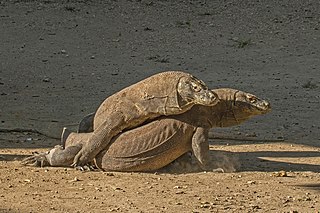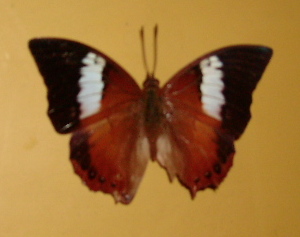
The Varanidae are a family of lizards in the superfamily Varanoidea and order Anguimorpha. The family, a group of carnivorous and frugivorous lizards, includes the living genus Varanus and a number of extinct genera more closely related to Varanus than to the earless monitor lizard (Lanthanotus). Varanus includes the Komodo dragon, crocodile monitor, savannah monitor, the goannas of Australia and Southeast Asia, and various other species with a similarly distinctive appearance. Their closest living relatives are the earless monitor lizard and chinese crocodile lizard. The oldest members of the family are known from the Late Cretaceous of Mongolia.

The earless monitor lizard is a semiaquatic, brown lizard native to the Southeast Asian island of Borneo. It is the only living species in the family Lanthanotidae and it is related to the true monitor lizards.

The Joinvilleaceae are a family of flowering plants with a single genus including four species. The APG II system, of 2003 assigns it to the order Poales in the clade commelinids in the monocots. The family consists of one genus with four currently accepted species, distributed from the Malay Peninsula to the Caroline Islands and high islands in the Pacific Ocean. It is evolutionarily significant as a relictual group closely related to grasses. They closely resemble large grass plants, in both general appearance and microanatomy, but possess fleshy fruits.
Alsophila borneensis, synonym Cyathea borneensis, is a species of tree fern native to southern parts of Thailand and Cambodia, as well as the Malay Peninsula and Borneo, where it grows in lowland forest at an altitude of 400–1100 m. The trunk is erect and usually up to 2 m tall or more. Fronds are bi- to tripinnate and 2–3 m long. The stipe is spiny and warty. It is covered with scattered scales that are dark, glossy and have narrow, fragile edges. Sori are close to fertile pinnule midveins and covered by thin indusia.

The Borneo elephant, also called the Bornean elephant or the Borneo pygmy elephant, is a subspecies of Asian elephant (Elephas maximus) that inhabits northeastern Borneo, in Indonesia and Malaysia. Its origin remains the subject of debate. A definitive subspecific classification as Elephas maximus borneensis awaits a detailed range-wide morphometric and genetic study. Since 1986, the Asian elephant has been listed as Endangered on the IUCN Red List as the population has declined by at least 50% over the last three generations, estimated to be 60–75 years. It is pre-eminently threatened by loss, degradation and fragmentation of habitat.

The Borneo shark is a species of requiem shark, and part of the family Carcharhinidae. Extremely rare, it is known only from inshore waters around Mukah in northwestern Borneo, though it may once have been more widely distributed. A small, gray shark reaching 65 cm (26 in) in length, this species is the only member of its genus with a row of enlarged pores above the corners of its mouth. It has a slender body with a long, pointed snout and a low second dorsal fin placed posterior to the anal fin origin.
Microhyla borneensis, also known as the Matang narrow-mouthed frog, is a species of microhylid frog found in the Matang Range in Sarawak, Borneo. It was once the smallest known frog from the Old World. Adult males of this species have a snout-vent length (SVL) of 10.6–12.8 mm (0.42–0.50 in), but adult males can reach a maximum of 13 mm (0.51 in),and adult females of this species have a snout-vent length of 16–19 mm (0.63–0.75 in), Tadpoles measure just 3 mm.

The Malaysian giant turtle or Bornean river turtle is a species of turtle in the family Bataguridae. It is monotypic within the genus Orlitia. It is found in Indonesia and Malaysia.

The Bornean horseshoe bat is a species of bat in the family Rhinolophidae. It is found in Brunei, Cambodia, Indonesia, Laos, Malaysia, and Vietnam.

Upuna is a monotypic genus of plants containing the single species Upuna borneensis. The genus name Upana is derived from its Iban name, upan. The species name borneensis refers to its distribution, being found only in Borneo. It is native to lowland mixed dipterocarp forests up to 400 meters elevation. It is a heavy hardwood similar to Vatica. While Upuna borneensis occurs in protected areas, it is threatened by logging, expansion of palm oil plantations and increasing frequency of fires.

Craspedocephalus borneensis, commonly known as the Bornean pit viper, is a venomous pit viper species endemic to the island of Borneo. No subspecies are currently recognized.

Agathis borneensis, also known as Borneo kauri, is a species of conifer in the family Araucariaceae.
Musa borneensis is a species of wild banana, native to the island of Borneo, in the Malaysian states of Sabah and Sarawak. It is placed in section Callimusa, having a diploid chromosome number of 2n = 20.
Diospyros borneensis is a tree in the family Ebenaceae. It grows up to 20 metres (70 ft) tall. Twigs are reddish brown when young, drying black. Inflorescences bear up to 20 flowers. The fruits are round, drying black, up to 4.2 cm (2 in) in diameter. The tree is named for Borneo. Habitat is forests from sea-level to 1,000 metres (3,300 ft) altitude. D. borneensis is found in Peninsular Thailand, Sumatra, Peninsular Malaysia and Borneo.

Scorodocarpus is a monotypic genus of plant in the family Olacaceae. It has also been classified in the family Strombosiaceae. The generic name is from the Greek meaning "garlic fruit", referring to the smell of the fruit. As of June 2014 The Plant List recognises the single species Scorodocarpus borneensis. The specific epithet borneensis is from the Latin meaning "of Borneo".

Pterolophia is a genus of longhorn beetles of the subfamily Lamiinae, containing the following species:

Charaxes bupalus is a butterfly in the family Nymphalidae. It was described by Otto Staudinger in 1889. It is endemic to Palawan in the Indomalayan realm.
Cephalocassis borneensis is a species of catfish in the family Ariidae. It was described by Pieter Bleeker in 1851, originally under the genus Pimelodus. It is found in brackish and freshwater bodies such as the Mekong river, with its habitat ranging between Thailand and Indonesia. It reaches a standard length of 30 cm (12 in). It feeds on a variety of finfish, mollusks, benthic crustaceans, and plant detritus.
Vatica borneensis is a tree in the family Dipterocarpaceae, native to Borneo.











